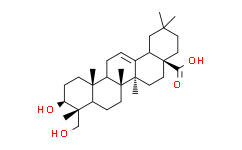| Cas No.: | 465-99-6 |
| Chemical Name: | Hederagenin |
| Synonyms: | Hederagenin;(3-beta,4-alpha)-3,23-dihydroxyolean-12-en-28-oicacid;3,23-dihydroxy-,(3-beta,4-alpha)-olean-12-en-28-oicaci;3-beta,23-dihydroxy-olean-12-en-28-oicaci;astrantiagenine;hederagenicacid;hederagenol;MELANTHIGENIN;CAULOSAPOGENIN;(4aS,6aR,6aS,6bR,8aR,9R,10S,12aR,14bS)-10-hydroxy-9-(hydroxymethyl)-2,2,6a,6b,9,12a-hexamethyl-1,3,4,5,6,6a,7,8,8a,10,11,12,13,14b-tetradecahydropicene-4a-carboxylic acid;HEDERAGENIN(AS);HEDERAGENIN(RG) PrintBack;Olean-12-en-28-oicacid, 3,23-dihydroxy-, (3b,4a)-;(3beta,4alpha)-3,23-Dihydroxyolean-12-en-28-oic acid;23-hydroxyoleanolic acid;3,23-Dihydroxyolean-12-en-28-acid;3,23-dihydroxyolean-12-en-28-oic acid;EINECS 207-369-9;3β,4α-3,23-Dihydroxyolean-12-en-28-oic Acid;[ "" ];Astrantiagenin E;Hederagenic acid;4-epi-hederagenin;RQF57J8212 |
| SMILES: | O([H])[C@@]1([H])C([H])([H])C([H])([H])[C@@]2(C([H])([H])[H])[C@]([H])([C@]1(C([H])([H])[H])C([H])([H])O[H])C([H])([H])C([H])([H])[C@@]1(C([H])([H])[H])[C@]3(C([H])([H])[H])C([H])([H])C([H])([H])[C@@]4(C(=O)O[H])C([H])([H])C([H])([H])C(C([H])([H])[H])(C([H])([H])[H])C([H])([H])[C@@]4([H])C3=C([H])C([H])([H])[C@@]12[H] |
| Formula: | C30H48O4 |
| M.Wt: | 472.6997 |
| Purity: | >98% |
| Sotrage: | 2 years -20°C Powder, 2 weeks 4°C in DMSO, 6 months -80°C in DMSO |
| Description: | Hederagenin is a triterpenoid saponin. It can inhibit LPS-stimulated expression of iNOS, COX-2, and NF-κBHederagenin can Exhibits multiple pharmacological activities in the treatment of hyperlipidemia, antilipid peroxidation, antiplatelet aggregation, liver protection, antidepression, anti-inflammation.[1]In vitro:1) Hederagenin can correct the imbalance of endothelial function by inhibiting the release of large amounts of iNOS and increasing eNOS contents and inhibits the IKKβ/NF-κB signaling pathway to reduce the release of IL-6, IFN-γ, TNF-α, and other inflammatory factors. [1]2) The EC50 of hederagenin is 39 ± 6 μM in A549 cancer cell line, but it's inactive for DLD-1 cells. [2]3) Hederagenin inhibited LPS-induced production of NO, PGE2and cytokines in cells.[3]4) Hederagenin had an anti-edema effect on the CA-induced mouse hind paw edema assay. [3]5) Hederagenin inhibited the CA-induced increase in skin thicknesses. [3]In vivo: The rats in the hederagenin group were administered hederagenin at 20 mg/kg/d via gavage.(More details please refer to the protocol below). In AS rat models induced by a high-lipid diet plus VD3, hederagenin can effectively reduce serum lipid, ALT, and AST levels, in addition to improving liver function, relieving high blood coagulation, and slowing blood flow and stasis by improving blood rheology. [1] |
| References: | [1]. Su-Hong Lu et al. Experimental Study of Antiatherosclerosis Effects with Hederagenin in Rats. Evid Based Complement Alternat Med, 2015, Oct 19 [2]. Diego Rodríguez-Hernández et al. Hederagenin as a triterpene template for the development of new antitumor compounds. Eur J Med Chem, 2015 Nov 13, 105:57-62 [3]. Chul Won Lee et al. Hederagenin, a major component of Clematis mandshurica Ruprecht root, attenuates inflammatory responses in RAW 264.7 cells and in mice. Int Immunopharmacol, 2015 Dec, 29(2):528-37. |






















